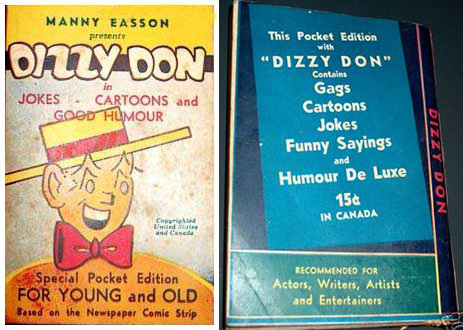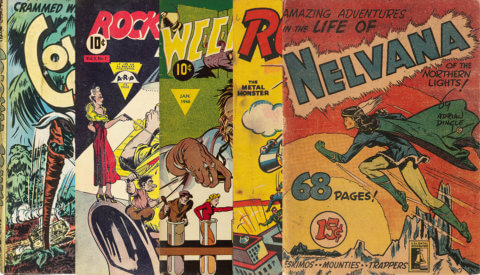
The Funny Comics was the penultimate main title to come out of Commercial Signs/Bell Features in the early forties. First came Wow Comics in Sept. of 1941, then Dime Comics and Active Comics in Feb. of 1942, followed by Joke Comics and the newly absorbed (from Hillborough Studios) Triumph Comics both popping up around June, 1942 and then The Funny Comics starting around July, 1942. Commando Comics was the last main title to appear, around Sept./Oct. of 1942 and closed out this famous alternate Canadian “Group of Seven.”

The Funny Comics was different from the other original Bell Features titles because it featured just one main character, Dizzy Don and the work of one main artist from start to finish that of his creator, Manny Easson. Dizzy himself was a Harry Langdon type of zany young man whose trademark was a straw boater always firmly balanced on his noggin’. The Funny Comics No. 1 was a 64 pager made up almost entirely (besides some ads and a two-page text story) of disconnected Dizzy Don one-page gags.

In The Funny Comics No. 2, however, Manny Easson had a brainwave to make the central content of the title not just a random set of Dizzy Don gags but a complete, full length (37 page) story featuring Dizzy Don as a detective and the front cover illustrated this change. Response must have been positive because these extra-long main stories continued to appear in The Funny Comics right up to its last Bell Features issue, No. 20. These well-written mystery stories ranged from 30 pages in length (issues 12, 13, and 14) up to the longest of 42 pages in The Funny Comics No 6.
Dizzy’s first job is that of a circus “barker” but he soon falls into a gig as a vaudeville comedian and makes such a success of it that he and is offered his own radio spot along with his sidekick Canary Bird picked up from his first vaudeville appearance. They quickly become a standout success eliciting comments from Charlie McCarthy and Jack Benny’s Rochester on p. 15 and 16 of The Funny Comics No. 2. The female interest throughout the run was Shirley Watson a band singer that Dizzy meets at his first radio broadcast. In The Funny Comics No. 16 we have the introduction of another “regular” into the group in the form of Dizzy Don’s cousin Silly Soozie, a young pig-tailed squirt of a trouble maker.


Dizzy became popular enough character for Bell Features that by the end of 1944 he had his own Big Little Book size digest of jokes and around the same time also turned up in his own colouring book and Silly Soozie got a counterpart colouring book for the girls.

The Funny Comics ended with its last issue No. 20 in the spring of 1945 (around May/June). After a hiatus of about a year the same numbering continued with a change in title to Dizzy Don Comics and a change in publishers from Bell Features to Dizzy Don Enterprises which may mean that Manny Easson retained the rights to his own character and went on to form his own publishing company. Dizzy Don Comics Vol. 2, No. 21 came out in the spring of 1946 and its contents were in full colour. Issue No. 22 followed in Oct. 1946 and was reprinted by F. E. Howard Publications (who had published those Archie/Pep reprints/redraws a few year back among others and had obtained the rights to a few Bell Features characters among them Dizzy – check out Super Duper Comics which was published around the same time in the States) in the U. S. as Dizzy Don Comics No. 3 followed by and issue No. 4 in Sept./Oct. 1947 with the Bell logo featured prominently on the cover and a couple of Bell Features characters on the back.



In a world of adventurers, superheroes, cowboys, and mounties, a simple character like Dizzy Don can be easily overlooked, but take a look again at Manny Easson’s long, winding, and funny stories and the lovable characters he created and you’ll be pleasantly rewarded.




Has anyone ever seen a copy of the Dizzy Don newspaper comic strip, pre-Bell Features?
Or is it just an urban legend started in the Great Canadian Comic Strips? You’d think that if it was in “over 60 newspapers” that some sample should have survived.
Sorry, wrong title. I meant to type “the Great Canadian Comic Books,” …the other book, G.C. Comics Strips, hasn’t been written. Yet.
I have several books with The Funny Comics with Dizzy Don by Manny Easson……if that is what you are looking. Plmk
Thanks for your post, Marilyn. I’d be interested in finding out what issues they are and what shape they are in.